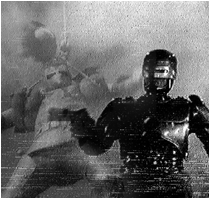
Bragança
de Miranda
Machine: The Funcional Impossibility
Carrilho da Graça
Performance (Interview)
Diller + Scofidio
Jump Cuts
Hani Rashid
The diference-Scape: The Digital Machine
Neil Denari
Interruped Projections
Rui Tavares
Seapking of Miguel Palma
Santa-Rita
The Mechanical Flirt
Machine: The Funcional Impossibility
Carrilho da Graça
Performance (Interview)
Diller + Scofidio
Jump Cuts
Hani Rashid
The diference-Scape: The Digital Machine
Neil Denari
Interruped Projections
Rui Tavares
Seapking of Miguel Palma
Santa-Rita
The Mechanical Flirt

The Mechanical Flirt
Lisbon 1998
The medieval warrior represents one of the frst sucessful fusions between Man and Machine (the armour), the creation of a new hybrid being, both natural and artificiall. A fiction turned reality - the robocop - centuries before its true existance, a new machine, a war device in which man and armour are defined by their own mechanical constrictions. A new machine whose global and detailed design embodies the human quest for power and supremacy, a machine where visual impact outrivals ability and offensive/defensive performance.
The systematic invention of mechanical systems acknowledges men´s endless efforts to extend his physical and intelectual skills, introducing effectiveness, accuracy, perfection and power in the world around him with unspeakable speed and strength. The invention of machines has stirred passion and seduction over men´s cunning imagination but, simultaneously, apprehension and distrust towards its interference on life´s diverse aspects. Thus, machines have always been a source of admiration and rejection.
Man has always sought with his fascination on the mechanical aspect of things to understand how new developments on production and research systems could establish new ways of expression and representation. The mechanical systems began to be seen not only as milestones of societies´ technological progress but also as aesthethic and ideological blueprints.
Leonardo Da Vinci´s artifacts (devices /visions foresighting the conquests and achievements of future worlds), Daniel Libeskind´s machines (extensions of an architectural research process) or Asymptote´s Steel Cloud (a turn-of-the-century construction/monument built on the sampling and mixing of events and movements accomplished by mechanicals connections) are all examples of a certain ability to upgrade the technological reality of their time or to recover and reinterpret ancient crafts and skills. Last but not least, they represent the power to adjust technological improvements to a new way of understanding architecture.
These constructions are not simply seeking a machine-like look through their composition, they seek a way to overcome, translate and interpret reality by inventing mechanical or kinetic systems that ensure a sucessful transmission of the knowledge acquired. Inventions and events designed to respond to specific doubts and difficulties felt in each moment, hoping to activate and promote new perspectives on the contemporary condition. Inventions which unleash new perspectives on groundbreaking concepts of form, program and production.
The cult of the mechanical can thus be understood not only as a fascination with the dynamics and actions of "things" but, above all, as a process, an effective procedure of adjustment and response to the foundations of everchanging worlds and realities. This should not be interpreted as a mere overload of technological gadgetry but as the exploration of an empirical and scientifical body of knowledge which is a form of expression in constant renewal and metamorphosis.
The research of new mechanical fabrications affects architecture in its exploration of spaces not dominated by classical frameworks and conventions of perception and communication but, in turn, defined by flexible systems able to challenge and compete with the constant technological innovations deployed in these last decades that radically shifted our comprehension of architecture and of the world.
One may interpret Rem Koolhaas´ Jussieu Library as an ingenious mechanical conversion of the dom-ino system in a "building" capable of storing all documents and information that define and virtually control knowledge in these final chapters of the 20th century. Le Corbusier dreamt about «une machine à habiter». The house in Bordeaux for a physically handicapped person Koolhaas also designed finally achieves that aspiration creating a space where its inhabitant - much as the medieval warrior in its armour - is just another "artifact" inside a sophisticated machine, designed and tuned to fulfill its own needs |